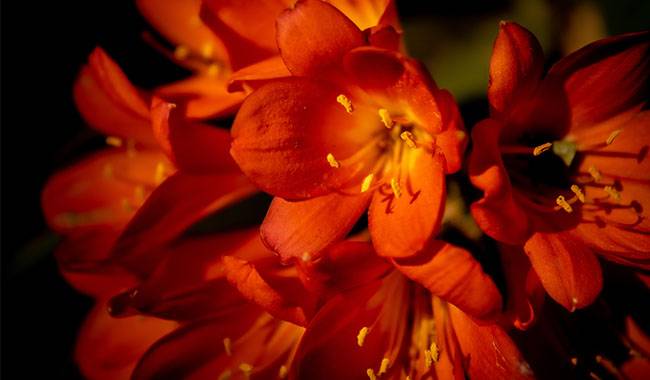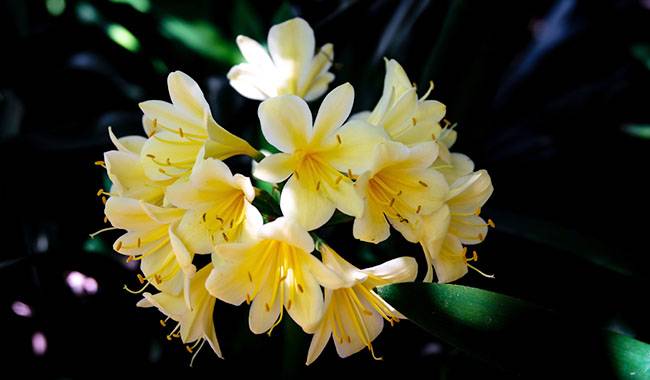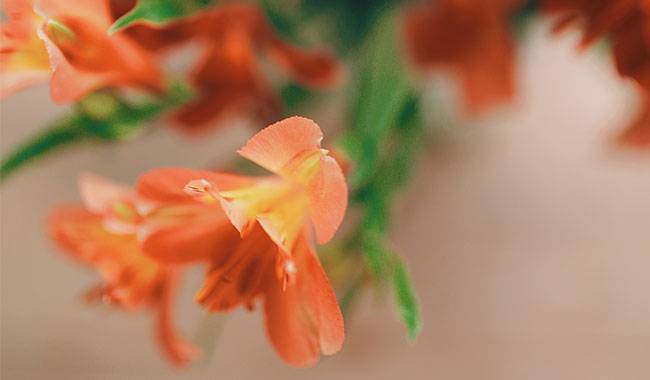
Clivia is one of the most conspicuous among those plants that at a glance conjure up images of magnificent bouquets. Its huge, elegant inflorescence set off by dark, glossy foliage is simply impossible to take your eyes off. With such a striking appearance, it is surprising that it has remained unpopular for such a long time. Thorough care and compliance with all condition recommendations are a must for her. But even so, spectacular longevity is not to be found in houseplants. I will show you how to take care of Clivia plants at home in the article on ThumbGarden.
PLANT DESCRIPTION AND SPECIES OF INDOOR CLIVIA FLOWERS
Clivia has long been considered an outdated, strictly greenhouse plant, but today they are gaining favor again in indoor cultivation. It is one of the most original of the beautifully flowering houseplants and one of the most striking exotics.
Members of the Amaryllis clivia family, also known as Amaryllidaceae, are quite controversial. This plant is simply surrounded by myths. There is even some debate about whether Clivia is a rhizomatous perennial or a bulbous perennial.
Clivias have a thickened, shortened rhizome that resembles a lily leaf and does not form a bulb. clivia species reach a height of 31 inches (80 cm), while modern varieties and hybrids are more compact.
The strap-like or paddle-shaped, rather long and wide leaves form pseudostems in two rows. clivia leaves reach up to 23 inches (60 cm) long, similar to those of Clivia. However, the rich color and dense foliage, which gives them a slight arching curve, make them stand out in comparison. These plants have a very effective glossy finish.
Clivia can surprise you in many ways, but first and foremost is its longevity. Under the right growing conditions, Clivia can last 40 years or more!
While the classic flowering period is late February through May, Clivia tends to flower a little later, in March. Umbrella-like inflorescences rise above the foliage on sturdy, vigorous flowering stems. Younger clivias produce one or more flowering stems, but older plants, especially after the first decade, are capable of producing half a hundred flowering stems in a single season.
Up to 60 large, funnel-shaped flowers are arranged in an umbel. The elegant, bell-shaped flowers are very graceful. After flowering, large, berry-like fruits are produced.
The yellow-orange color of Clivia’s flowers is reminiscent of summer fruits. Cream, apricot, melon, pink-peach, and vermilion-pink clivia always look sunny and dazzling.
Clivia is a poisonous houseplant, and you need to protect your skin from contact with the sap when working with it.
TYPES OF INDOOR CLIVIA FLOWERS
Clivia miniata (Bush lily) is the most common and colorful viburnum. The banded leaves are very dark and stunning. But this species is valued for its blooms – huge inflorescences of large yellow, orange or light red flowers.
Clivia nobilis is distinguished only by its slender, tubular, pendulous flowers, which are mostly pink.
GROWING CONDITIONS OF CLIVIA OUTDOORS

Without a cool overwinter, Clivia will not bloom to its full potential. The remaining requirements should not be overlooked: Clivias prefer a stable environment and do not like to be touched unnecessarily.
Lighting and placement
Clivia is a light-loving plant that does not bloom in the shade. However, direct sunlight, especially in summer, is also not good for it. Clivia is placed in an area with diffused light, near a window, but not necessarily on a windowsill.
When choosing a location for Clivia, the focus should be on consistency: Clivia does not tolerate even small changes and “disturbances”. Moving the pot, even slightly, is not recommended; moving it to a new location can cause considerable problems. Clivia also does not like to be touched too much, touched too often, turned over, or crowded – the foliage should not touch walls, windows, or surfaces.
Temperature control and ventilation
Clivia prefers a cool environment and should be overwintered in a room with a maximum temperature of 59 °F (15°C). The ideal temperature range for the resting period is 46-53 °F (8-12°C) – (from September to January). However, it does not tolerate the high temperatures of summer either. A temperature of 59-68 °F (15-20°C) is best.
In summer, Clivia can be brought into the fresh air by placing it in a semi-shady and shady place. Even in the winter, the room should be regularly ventilated. Clivia will tolerate slight drafts as long as there is no temperature difference.
HOW TO CARE FOR CLIVIA FLOWERS AT HOME

It is not for nothing that watering is considered to be the key to producing a large number of flowers each year. Without proper, consistent soil moisture, Clivia will be capricious and bloom sparsely, and even cool overwinters will not be successful without changes in watering schedule and methods.
Watering and air humidity
Water Clivia according to its stage of development. Water Clivia regularly from the time the flower stems reach 6 inches (15 cm) tall until fall. Avoid humidity, but maintain a steady moisture content as the substrate surface dries out.
However, starting in the fall and until the flower stems start to grow, Clivia can be kept cool and not watered at all. If the temperature exceeds the optimum level, water Clivia very gently and infrequently. During the dormant period, it needs light moisture and can be simply sprayed with a sprayer to lightly moisten the soil and leaves.
The warmer the temperature, the heavier the watering, still allowing the substrate to dry to a third of its depth. Once the flower stems have grown to 6 inches (15 cm), water heavily again, but without a smooth transition. clivia should be watered at a temperature slightly warmer than the air in the room. Water should not be left in the tray, not even for a few minutes.
Clivia only dislikes very dry air and proximity to heaters or air conditioners. It is quite happy with a medium to low maintenance spray and does not need a humidifier.
Clivia leaves are best kept clean by gently wiping away dust with a damp sponge. Do not wipe too often or too vigorously to keep the procedure to a minimum.
Fertilizer and fertilizer components
Feed Clivia only during the peak growing season. start feeding at the beginning of the growing season and stop feeding in the fall. clivia needs half the amount of fertilizer, once a week during the growing season (2-3 weeks after resuming irrigation) to the flowering period. After flowering until September, fertilize at the standard rate of once every 2-3 weeks. Only fertilizers from the flowering crop should be used for this plant.
Pruning and repotting
Pruning is limited to removing flowering stems only. Pruning of leaves is poorly tolerated except for wilted greens.
Clivia does not like to be repotted frequently. Transplant only the first few years annually or every two years as the pot space fills up. Mature Clivia is transplanted every 3-4 years, slightly expanding the container. When the maximum size of the container is reached, no more Clivia should be transplanted. only replace the topsoil twice a year or at least in the spring and fertilize more intensively.
This plant prefers containers that are not very tall and narrow. Because Clivia is large, grows in clusters, and has heavy inflorescences, it needs to be planted in very sturdy containers or have strong drainage. Ceramic planters are ideal for Clivia flowers.
These plants prefer a nutritious, clayey, coarse substrate-the special soil for Clivia flowers.
Clivias in the room are only affected by humidity and rot due to standing water at the bottom of the soil. Near infected plants, they are quickly “attacked” by scabies and mealybugs.
PROPAGATION OF CLIVIA FLOWERS
The main method of propagation of Clivias is simple division. Clivia grows so large that it is possible to divide the old plant into 2-3 parts at each transplanting or to separate the individual substrates.
Clivia is not easy to grow from seed, and you will have to wait at least 5 years for the first flowering. Sow the freshly harvested seeds in light soil, lightly covered with a layer of sand. Under film or glass at about 73 °F (23°C), seedlings emerge unevenly and slowly. First-year seedlings are very fragile and need to be harvested several times.







